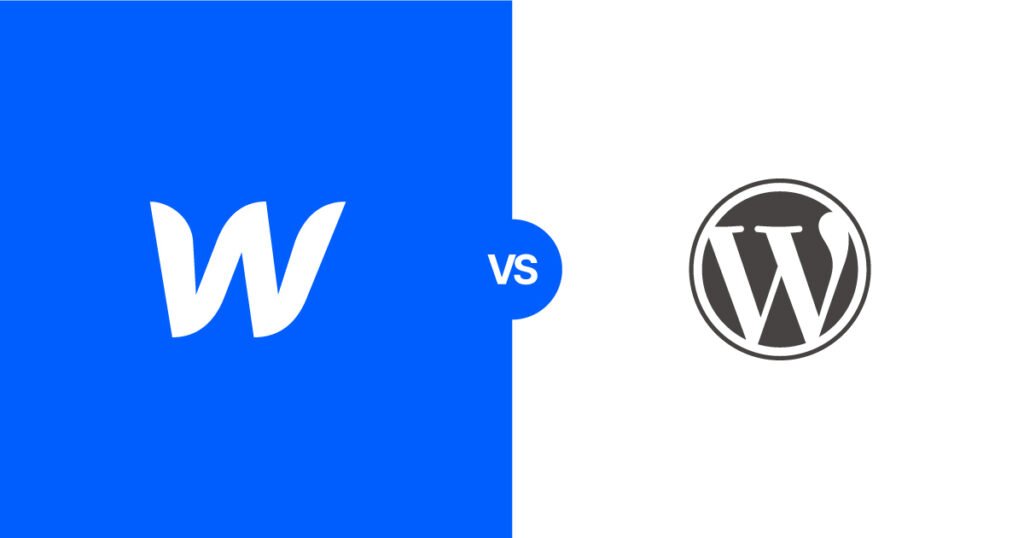Building a website is no longer the daunting task it used to be. With the advent of website builders and content management systems, anyone can create a website, regardless of their coding skills. But with so many platforms available, it can be tough to decide which one to use.
In this article, we’re going to compare two popular website-building platforms: Webflow and WordPress. We’ll look at the pros and cons of each platform, their features, and their pricing, so you can decide which one is right for you.

What is Webflow?
Webflow is a website builder that allows you to design and build websites without writing any code. It provides a drag-and-drop interface for building pages and a content management system (CMS) for managing content. Webflow is known for its flexibility and customization options, making it a great choice if you want full control over the design and functionality of your website.
One of the key benefits of using Webflow is the ability to design a website from scratch without relying on templates or pre-built themes. This means you can create a truly unique website that stands out from the crowd. Webflow also offers a range of design tools and features, such as CSS Grid and Flexbox, which allow you to create complex layouts and designs.
Another benefit of using Webflow is the ability to manage your content through the CMS. You can create collections of content, such as blog posts or product pages, and customize the fields and structure of each collection. This allows you to create a website with a complex content structure, without having to write any code.
What is WordPress?
WordPress is a content management system (CMS) that powers over 40% of all websites on the internet. It’s an open-source platform that allows you to build and manage websites using a combination of themes, plugins, and custom code. WordPress is known for its user-friendly interface, scalability, and extensive library of plugins and themes.
One of the key benefits of using WordPress is its flexibility. You can use WordPress to build any type of website, from a simple blog to a complex e-commerce site. WordPress also offers a range of plugins and themes that allow you to add functionality and customize the design of your website.
Another benefit of using WordPress is the user-friendly interface. WordPress has a simple and intuitive interface that makes it easy to manage your content, customize your site, and install plugins and themes. This makes it a great choice for beginners or those without coding experience.

Webflow vs WordPress: Which Platform Should You Use?
Now that we’ve looked at the features and benefits of both platforms, let’s compare them side-by-side to see which one is right for you.
Ease of Use
When it comes to ease of use, Webflow is the clear winner. Webflow is a visual website builder, so you can design your website using a drag-and-drop interface, without needing any coding skills. WordPress, while user-friendly, requires a bit of a learning curve to fully master.
Customization
When it comes to customization, Webflow is also the clear winner. Webflow offers more customization options than WordPress, as it allows you to create custom designs without needing to rely on themes or plugins. However, if you have development skills or access to a developer, you can customize WordPress to meet your needs.
Functionality
When it comes to functionality, both platforms offer a range of features and integrations. However, WordPress has a larger library of plugins and themes available. If you need a specific feature or integration, you’re more likely to find it on WordPress.
Cost
When it comes to cost, Webflow is a subscription-based service, with plans ranging from $12 to $212 per month, depending on your needs. WordPress, on the other hand, is open-source and free to use. However, you will need to pay for web hosting, a domain name, and potentially plugins and themes.
If you’re looking for a cost-effective solution, WordPress may be the better choice. However, if you value the time-saving features and ease of use of Webflow, the subscription cost may be worth it.
Support
When it comes to support, both platforms offer a range of resources. Webflow has a comprehensive knowledge base, video tutorials, and a support team available via email or live chat. WordPress also has a large community of users and developers who offer support and resources.
Ultimately, the platform you choose will depend on your specific needs and skill set. If you value customization and design flexibility, Webflow may be the better choice. However, if you need a cost-effective solution with a large library of plugins and themes, WordPress may be the better choice.
If you’re still not sure which platform to use, consider the following questions:
- Do you have coding skills or access to a developer?
- How important is design flexibility and customization to you?
- How much are you willing to spend on a website builder?
- What features and functionality do you need for your website?
- How important is ease of use and a user-friendly interface to you?
Answering these questions can help you make an informed decision about which platform is right for you.
Conclusion
Webflow and WordPress are both great platforms for building websites, but they have different strengths and weaknesses. Webflow is ideal for those who value design flexibility and customization, while WordPress is ideal for those who need a cost-effective solution with a large library of plugins and themes.
Ultimately, the platform you choose will depend on your specific needs and skill set. Both platforms offer a range of features and support resources, so you can be confident that you’ll be able to create a website that meets your needs, regardless of which platform you choose.


